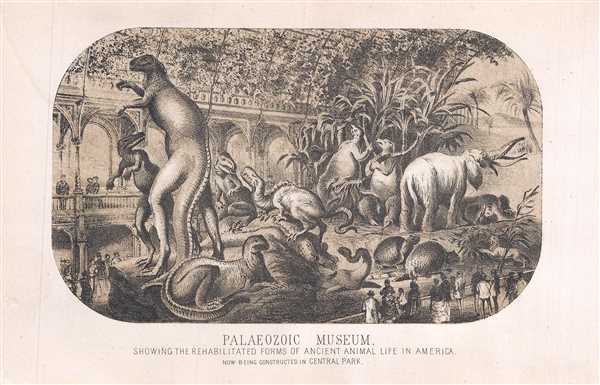This item has been sold, but you can get on the Waitlist to be notified if another example becomes available, or purchase a digital scan.
1860 Engraving of the Hawkins' Palaeozoic Museum, New York City
NaturalHistoryMuseum-vaux-1860$75.00

Title
Palaeozoic Museum. Showing the Rehabilitated Forms of Ancient Animal Life in America. Now being constructed in Central Park.
1860 (undated) 5 x 7.5 in (12.7 x 19.05 cm)
1860 (undated) 5 x 7.5 in (12.7 x 19.05 cm)
Description
A wonderful 1870 view of the intended interior of the Central Park Palaeozoic Museum – a precursor of the modern day Natural History Museum. Following the success of Benjamin Waterhouse Hawkins' life-sized concrete dinosaur models created for England's Crystal Palace for the Great Exhibition of 1851, in 1868 the Commissioners of Manhattan's newly created Central Park recruited the sculptor to create replicas of America's antediluvian giants for a proposed museum in Central Park. The museum was to have been known as the Paleozoic Museum (or Palaeozoic Museum), and foundations for the structure were laid by architects Clavert Vaux and Frederick Law Olmsted at Central Park West and 63rd Street. Like Hyde Park's Crystal Palace, Hawkins' display was to be housed within a great iron frame and an arched glass roof. Surviving sketches and photographs show that Hawkins had planned an elaborate, if anachronistic, menagerie, mixing Mesozoic dinosaurs, plesiosaurs, and mosasaurs with extinct Cenozoic mammals.
Unfortunately for Hawkins and future generations, the planned museum ran afoul of 19th Century New York's corrupt politics. After Hawkins spoke out publicly against 'Boss' William Magear Tweed, vandals in the employ of Tweed broke into Hawkins' workshop on a spring day in 1871 and used sledge-hammers to reduce the seven finished models and their molds, as well as other materials, to rubble. The ruined sculptures were then buried somewhere near the southwestern corner of the park.
Although the Palaeozoic Museum never manifested, it did inspire the dioramas of the subsequent Natural History Museum which still operates today just outside the borders of the Park.
Unfortunately for Hawkins and future generations, the planned museum ran afoul of 19th Century New York's corrupt politics. After Hawkins spoke out publicly against 'Boss' William Magear Tweed, vandals in the employ of Tweed broke into Hawkins' workshop on a spring day in 1871 and used sledge-hammers to reduce the seven finished models and their molds, as well as other materials, to rubble. The ruined sculptures were then buried somewhere near the southwestern corner of the park.
Although the Palaeozoic Museum never manifested, it did inspire the dioramas of the subsequent Natural History Museum which still operates today just outside the borders of the Park.
Condition
Very good.

